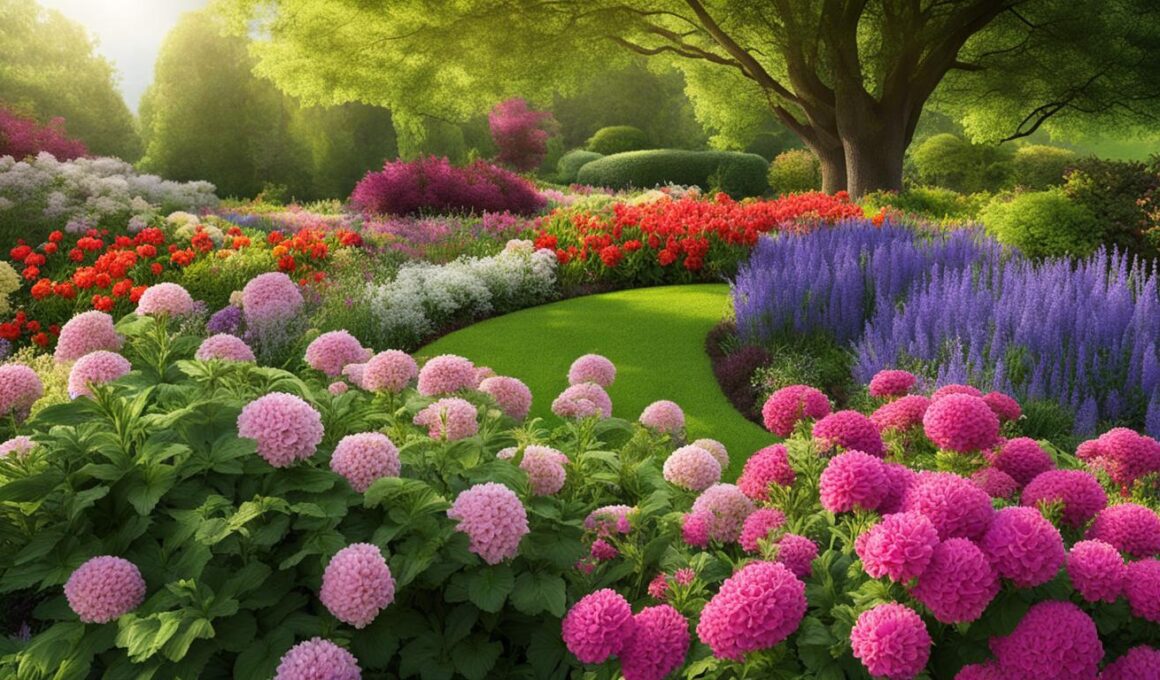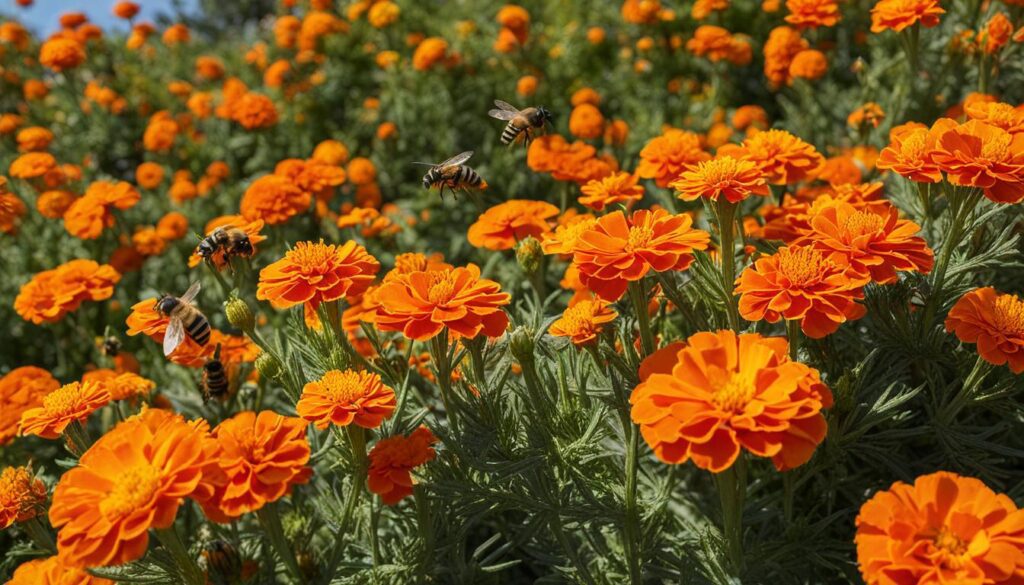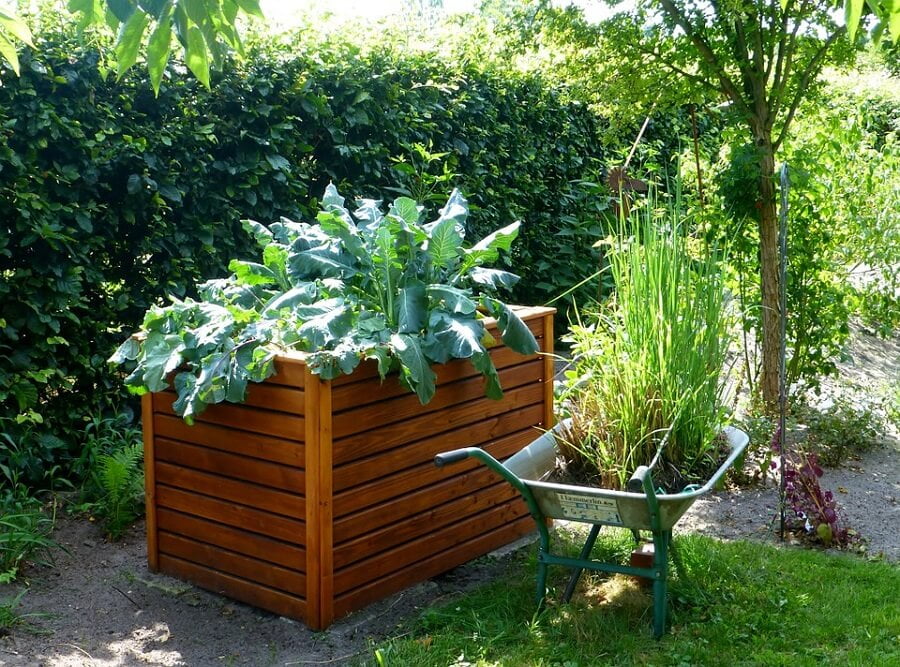There are some flowers and plants that can help deter bees from your garden. While it’s important to remember that bees are crucial pollinators, there may be situations where you want to minimize the presence of bees, such as if you or someone in your family is allergic to bee stings. Certain plants emit fragrances or have characteristics that make them less enticing to bees, making them suitable options for creating a bee-free garden oasis.
Key Takeaways:
- Flowers and plants can help deter bees from your garden.
- Consider planting basil, geraniums, and marigolds to repel bees.
- Balance a bee-free zone with maintaining a bee-friendly environment.
- Avoid planting attractive flowers near areas where you want to keep bees away.
- Non-flowering plants, such as evergreen shrubs, can also deter bees.
Basil: A Bee-Repellent Herb for Your Garden
Basil is not only a popular herb known for its culinary uses, but it can also serve as a natural insect-repellent plant in your garden. While it may attract honeybees when it blooms, many other insects, including bees, are not particularly fond of its scent when it is not flowering.
This makes basil an excellent choice for those who want to repel bees while still maintaining a bee-friendly garden. Consider planting basil in areas where you don’t want bees to be present, such as near walkways or seating areas. Not only will you have a herb that adds flavor to your dishes, but you’ll also deter bees from those specific areas.
By incorporating basil into your garden, you can create a fragrant and beautiful space while reducing the presence of bees in certain areas. It’s important to note that while basil can help repel bees, it’s crucial to maintain a balance between creating a bee-free zone and supporting these important pollinators. Remember to plant attractive flowering plants elsewhere in your garden so that bees still have access to the nectar and pollen they need to survive.
Benefits of Basil as a Bee-Repellent Herb:
- Repels bees due to its scent when not flowering
- Can be planted in areas where you want to minimize bee presence
- Adds flavor to your dishes as a culinary herb
- Contributes to a fragrant and beautiful garden space
“Basil is a great choice for those looking to repel bees while still enjoying the benefits of a bee-friendly garden.”
Geraniums: Strong-Scented Flowers to Ward Off Bees
When it comes to creating a bee-friendly landscape while simultaneously deterring bees from specific areas of your garden, geraniums are an excellent choice. These flowers are known for their strong scent, which can be off-putting to many insects, including bees. By planting geraniums strategically, you can create a bee-repellent area without compromising the overall health of your garden.
Gardeners have found that red geraniums are particularly effective in warding off bees. Bees perceive the color red as black, making red geraniums less inviting to these pollinators. Additionally, geraniums produce minimal amounts of pollen, further reducing their attractiveness to foraging bees. By incorporating red geraniums into your garden, you can create a visually appealing space that is less likely to attract bees.
Geraniums are a versatile option for bee repulsion as they can be planted both in the ground and in pots. This flexibility allows you to create bee-free zones throughout your garden or move the plants as needed. Whether you place them near seating areas, walkways, or other places where you want to keep bees away, geraniums provide an effective solution for those seeking to minimize bee visitation while still maintaining a bee-friendly environment.
Marigolds: Colorful Flowers with Little Bee Attraction
Marigolds are a popular choice for gardeners looking to deter stinging insects, including bees, from their outdoor spaces. These vibrant flowers not only add a burst of color to your garden but also have properties that make them unappealing to bees.
One of the reasons marigolds repel bees is their pungent odor. The strong scent of marigolds can discourage bees from lingering around your garden, making them an excellent addition to areas where you want to minimize bee visitation. Additionally, marigolds emit minimal pleasing fragrance and contain little pollen, reducing their attractiveness to foraging bees.
Marigolds can be incorporated into your garden as companion plants, helping to deter insects that damage your vegetables. Their bright orange and deep red shades make them not only aesthetically pleasing but also effective at deterring bees. By strategically placing marigolds in your garden, particularly near areas where you want to keep bees away, you can create a bee-free zone without compromising the overall health of your garden.
Conclusion
While there are some flowers and plants that can help deter bees from your garden, it’s important to remember the crucial role they play as pollinators. Bees are essential for the health of our ecosystems and the production of food. When using plants to repel bees, it’s essential to strike a balance between creating a bee-free zone and maintaining a bee-friendly environment.
Avoid planting bee-attractive flowers near areas where you want to keep bees away. Instead, opt for flowers that are known to be repellent to bees, such as basil, geraniums, and marigolds. These natural bee repellents emit fragrances or have characteristics that make them less enticing to bees. By incorporating these flowers into your garden, you can create a space where you can relax without the constant presence of bees.
It’s also worth considering non-flowering plants, such as evergreen shrubs, to incorporate into your landscape. These plants provide beauty and greenery without attracting bees. They can serve as a buffer zone between bee-attractive flowers and the areas where you want to keep bees away. Remember to do your research and select the right plants for your specific needs.
In conclusion, keeping bees away from certain areas of your garden is possible without completely excluding them from your outdoor space. By carefully choosing flowers repellent to bees, incorporating non-flowering plants, and maintaining a diverse garden, you can create an environment that balances your desire to deter bees with the need to support these important pollinators.
Are the Flowers That Repel Bees the Same as the Plants That Repel Bees?
Yes, the flowers that repel bees are the same as the plants that repel bees. Certain plants produce natural scents that repel bees, making them effective plant repellent for bees. Some examples include citronella, eucalyptus, and marigold. Planting these around your home can help keep bees at bay.
FAQ
Can these plants completely eliminate bees from my garden?
While certain flowers and plants can help deter bees, it is unlikely that they will completely eliminate bees from your garden. It’s important to maintain a balance between creating a bee-free zone and supporting these important pollinators.
Are these plants harmful to bees?
These plants are not harmful to bees. They simply have characteristics that make them less enticing to bees, such as emitting fragrances that bees may not prefer or having minimal pollen.
Can I still enjoy the benefits of a bee-friendly garden if I use these plants?
Yes, you can still enjoy a bee-friendly garden by strategically planting these bee-repellent plants in areas where you want to minimize bee visitation. Avoid planting them near areas where you want to attract bees, such as pollinator gardens or flower beds.
Are there non-flowering plants that can help deter bees from my garden?
Yes, consider incorporating non-flowering plants such as evergreen shrubs into your landscape. These plants can provide greenery and structure to your garden while minimizing bee visitation.
Can these bee-repellent plants be grown in pots?
Yes, basil, geraniums, and marigolds can all be grown in pots. This makes them versatile choices for creating bee-repellent areas in your garden, even if you have limited space.
How can I strike a balance between deterring bees and supporting pollinators?
When using plants to repel bees, consider planting them in areas where you don’t want bees to be present, such as near walkways or seating areas. This way, you can create a bee-free zone while still providing other areas of your garden with bee-attractive flowers to support pollinators.










